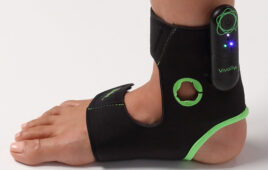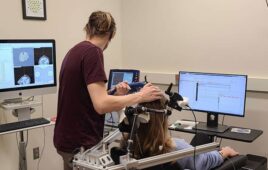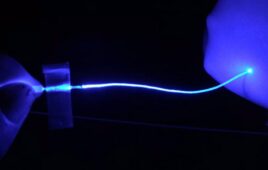First-generation devices used in the neurovasculature mimicked those designed for the coronary or peripheral vasculature. They proved that not all vessels are alike, and device design shouldn’t be either.
Emily Wozniak, Integer Holdings

A neurovascular stent delivery system [Image courtesy of Integer Holdings]
Wire-based delivery systems
Self-expanding stents designed for peripheral vascular applications are often delivered using a 6 or 8 Fr catheter and a pusher for deployment, which is too large for the narrow anatomy of the neurovasculature. Engineers minimized device profile by downsizing to wire-based delivery systems that deliver stents and flow diverters through microcatheters as small as 2 Fr. These wire-based systems achieve the ultra-low profile and flexibility needed for navigating the vasculature of the brain.
The stent delivery wires are specially designed, polymer-jacketed or nitinol guidewires with intricate bumper protrusions that push or pull the implant to deploy or re-deploy through a microcatheter. These wires must perfectly balance pushability to reach increasingly distal regions with the flexibility to navigate tortuous anatomy. Vessels in the brain are narrower and more sensitive than the periphery, so it is also critical to ensure these delivery systems have soft, atraumatic tips.
Complex devices require complex manufacturing
Achieving the right design is only part of the challenge. The other critical piece is developing the right manufacturing technologies that consistently and efficiently produce the intricate geometries required of wire-based delivery systems at commercial scale.
Case in point, the distal tip of the stent delivery wire is typically modified by grinding, coiling, soldering and laser welding to achieve the precise features that engage the stent to move it through the microcatheter. These processes can be difficult to develop, automate and scale, so considering the right manufacturing strategy and engaging with experts is critical early in the product design.
Micro-grinding: Think small
A corewire grinding process is often employed for two critical design features of the stent delivery wire: the taper of the distal tip and the creation of the protrusions that engage the implant. The distal tip taper determines the stiffness profile while maintaining flexibility without compromising navigation through tortuous vasculature. The design of the stent’s push/pull feature is usually simple: the distal end of the core wire is ground down to create two or more protruding “bumps” with 90-degree angles that catch on the implant to push or pull it through the microcatheter.
The difficulty is in the miniaturized scale. The wire’s distal tip may need grinding to diameters as small as 0.007 in., with the protrusions ranging from 0.010 in. to 0.025 in. It may also be necessary to use complementary processes such as micro-deburring methods alongside micro-grinding to round out the corners of the protrusions and ensure the device design is atraumatic. The development of micro-grinding processes with tolerances tight enough to reliably achieve complex geometry requires significant engineering expertise.
Another common challenge is that standard, automated equipment that can achieve these complex grind geometries doesn’t exist. To solve this problem, manufacturers have had to build their own custom equipment to automate precision micro-grinding.
Micro-coiling: Precision matters
Some stent-delivery wire designs incorporate small coils on the distal tip to minimize trauma during deployment. The efficient and cost-effective coiling of wires around tips as small as 0.007 in. is a manufacturing challenge that takes specialized skill and insight.
Like precision micro-grinding, coiling on this scale requires specialized equipment capable of achieving extremely tight tolerances. Coils must be wound around the ground distal tip and seamlessly integrated with the surrounding geometry.
Laser welding or soldering are used when attaching the coils to the wire in order to achieve seamless integration. This not only poses a challenge because of the small scale, but also because it often involves joining two different types of metals. Specialized lasers with small spot sizes and precision fixtures are critical to join the coils to the wire.
Finishing touches
Corewire design is not the only design and manufacturability consideration for neurovascular stent delivery wires. Many systems may also include a tapered polymer jacket to improve lubricity and ease movement in the microcatheter. Radiopaque micro-coils or marker bands are sometimes added near the protrusions, allowing physicians to visualize the location of the implant while still positioned on the wire. Other complex design features may be added to the delivery wire to allow for re-capture and re-deployment of a partially deployed stent if a physician wants to adjust the stent position. These design decisions must be made with the end goal of commercial-scale manufacturing strategy in mind.
Find experts you can trust
Companies that design neurovascular interventional devices focus on perfecting the product design from a clinical perspective. However, the challenges of manufacturing wire-based delivery systems make it necessary to factor in commercial manufacturing strategies early. Contract manufacturers have the specialized expertise and equipment needed to help ensure the manufacturing strategy for neurovascular product commercialization is efficient and reliable, ultimately maximizing speed to market and cost-effective commercial production.
Emily Wozniak is product manager for the peripheral vascular divisions products at Integer Holdings. She supports neurovascular product development and customer program execution, and develops and executes commercial strategy. Wozniak’s previous roles included the development and execution of commercial strategy for biologic contract manufacturers and startup medical device companies.
The opinions expressed in this blog post are the author’s only and do not necessarily reflect those of Medical Design and Outsourcing or its employees.




